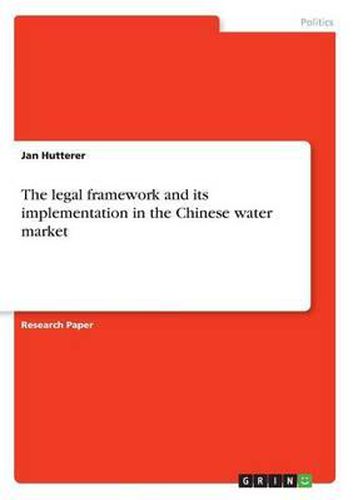Readings Newsletter
Become a Readings Member to make your shopping experience even easier.
Sign in or sign up for free!
You’re not far away from qualifying for FREE standard shipping within Australia
You’ve qualified for FREE standard shipping within Australia
The cart is loading…






Research Paper (postgraduate) from the year 2008 in the subject Politics - International Politics - Environmental Policy, grade: keine, 24 entries in the bibliography, language: English, abstract: Worldwide the hidden costs of Chinas rapid transformation have caused deep concerns. In recent years the cases of water shortages, pollution and flood/drought damages steadily increased in numbers. This development is caused by both a large population and a rapidly developing economy. Although China significantly improved its water and wastewater infrastructure, its water shortage problem is worsening year by year. The Chinese government tries to counter this misbalance and insistently pursues an environmentally sustainable development policy. Its countermeasures include management model reforms, Private-Sector-Participation (PSP) projects and the support of new technology development and application. According to the 11th Five-Year-Plan, more than 140 billion Euros will be spent on environmental projects and campaigns before 2010. These reforms have unleashed a wave of optimism in Chinaâ s water market and created great market opportunities for investors. Significant amounts of new water infrastructures are to be built, and the operation and maintenance of all existing and newly built municipal water and wastewater treatment plants have been or will be transferred to authorized enterprises. However, these opportunities are not without risk. Investors are particularly skeptical about the development of the legal environment. The contradiction of theory and practice is striking. On one hand Chinaâ s legal framework for environmental protection appears extensive and strict. On the other hand a violation of these regulations is seldom sanctioned. This paper tries to analyze this ambivalent picture. It examines the key regulations of the Chinese water sector, illustrates the interdependencies between the relevant authorities and analyzes their implications on investment opport
$9.00 standard shipping within Australia
FREE standard shipping within Australia for orders over $100.00
Express & International shipping calculated at checkout
Research Paper (postgraduate) from the year 2008 in the subject Politics - International Politics - Environmental Policy, grade: keine, 24 entries in the bibliography, language: English, abstract: Worldwide the hidden costs of Chinas rapid transformation have caused deep concerns. In recent years the cases of water shortages, pollution and flood/drought damages steadily increased in numbers. This development is caused by both a large population and a rapidly developing economy. Although China significantly improved its water and wastewater infrastructure, its water shortage problem is worsening year by year. The Chinese government tries to counter this misbalance and insistently pursues an environmentally sustainable development policy. Its countermeasures include management model reforms, Private-Sector-Participation (PSP) projects and the support of new technology development and application. According to the 11th Five-Year-Plan, more than 140 billion Euros will be spent on environmental projects and campaigns before 2010. These reforms have unleashed a wave of optimism in Chinaâ s water market and created great market opportunities for investors. Significant amounts of new water infrastructures are to be built, and the operation and maintenance of all existing and newly built municipal water and wastewater treatment plants have been or will be transferred to authorized enterprises. However, these opportunities are not without risk. Investors are particularly skeptical about the development of the legal environment. The contradiction of theory and practice is striking. On one hand Chinaâ s legal framework for environmental protection appears extensive and strict. On the other hand a violation of these regulations is seldom sanctioned. This paper tries to analyze this ambivalent picture. It examines the key regulations of the Chinese water sector, illustrates the interdependencies between the relevant authorities and analyzes their implications on investment opport